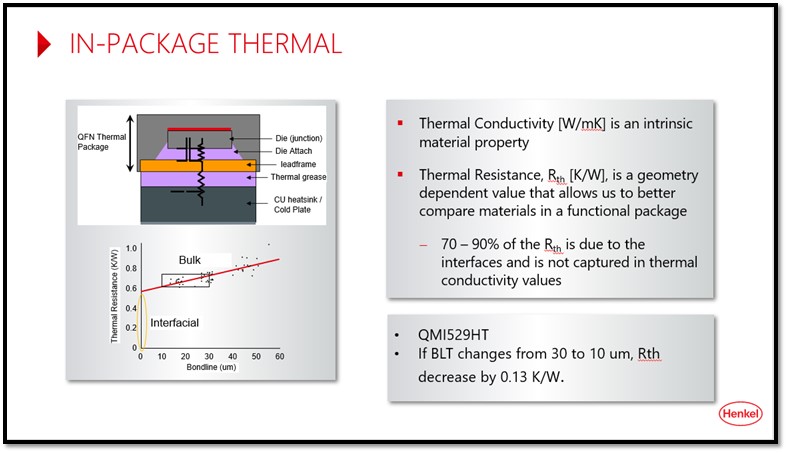LOCTITE ABLESTIK QMI529HT
- Void free bondline
- Excellent thermal conductivity
- Stable at high temperatures
Product Description
LOCTITE ABLESTIK QMI529HT die attach paste was developed as a soft-solder replacement or for high UPH performance applications. Maximum productivity is realized through in-line cure, either on the diebonder using a post diebond heater or on the wirebonder preheater.
Taking the relatively high viscosity and thixotropy of QMI 529HT into account, we believe that it’s worth testing this world wide established and proven die attach paste using stencil printing in parallel. QMI 529HT should have the potential to print small dots like ~100um diameter.
LOCTITE ABLESTIK QMI529HT is a hydrophobic BMI/acrylate product that exhibits excellent electrical and thermal conductivity and is stable at high temperatures. It offers high resistance to delamination and excellent adhesive strength with a void free bondline.
LOCTITE ABLESTIK QMI529HT works great on Copper, Silver plated copper, Preplated NiPdAu leadframe and Alloy 42, has high resistance to heat and humidity and good resistance to "popcorning" after exposure to reflow temperatures.
Snap Cure
- 60 seconds @ 185°C
Oven Cure
- 30 minutes @ 185°C or
- 30 minutes @ 200 to 220°C (for higher adhesion)
Technical Specifications
| General Properties | |||||||||
| |||||||||
| Specific Gravity Specific Gravity Specific gravity (SG) is the ratio of the density of a substance to the density of a reference substance; equivalently, it is the ratio of the mass of a substance to the mass of a reference substance for the same given volume. For liquids, the reference substance is almost always water (1), while for gases, it is air (1.18) at room temperature. Specific gravity is unitless. | 4.10 | ||||||||
| Work life @25°C Work life @25°C Work life is the amount of time we have to work with a material until it is no longer able to be easily worked and applied on a substrate. It is based on the change in viscosity and it can rely on the application requirements. | 24 hours | ||||||||
| Physical Properties | |||||||||
| Thixotropic index Thixotropic index Thixotropic Index is a ratio of a material s viscosity at two different speeds in Ambient temperature, generally different by a factor of ten. A thixotropic material s viscosity will decrease as agitation or pressure is increased. It indicates the capability of a material to hold its shape. Mayonnaise is a great example of this. It holds its shape very well, but when a shear stress is applied, the material easily spreads. It helps in choosing a material in accordance to the application, dispense method and viscosity of a material. | 4.8 | ||||||||
| Viscosity Viscosity Viscosity is a measurement of a fluid’s resistance to flow. Viscosity is commonly measured in centiPoise (cP). One cP is defined as the viscosity of water and all other viscosities are derived from this base. MPa is another common unit with a 1:1 conversion to cP. A product like honey would have a much higher viscosity -around 10,000 cPs- compared to water. As a result, honey would flow much slower out of a tipped glass than water would. The viscosity of a material can be decreased with an increase in temperature in order to better suit an application | 18,500 mPa.s | ||||||||
| Chemical Properties | |||||||||
| |||||||||
| Mechanical Properties | |||||||||
| |||||||||
| Thermal Properties | |||||||||
| |||||||||
| Glass Transition Temperature (Tg) Glass Transition Temperature (Tg) The glass transition temperature for organic adhesives is a temperature region where the polymers change from glassy and brittle to soft and rubbery. Increasing the temperature further continues the softening process as the viscosity drops too. Temperatures between the glass transition temperature and below the decomposition point of the adhesive are the best region for bonding. The glass-transition temperature Tg of a material characterizes the range of temperatures over which this glass transition occurs. | 3.3 °C | ||||||||
| Thermal Conductivity Thermal Conductivity Thermal conductivity describes the ability of a material to conduct heat. It is required by power packages in order to dissipate heat and maintain stable electrical performance. Thermal conductivity units are [W/(m K)] in the SI system and [Btu/(hr ft °F)] in the Imperial system. | 6.5 W/m.K | ||||||||
Additional Information
QMI529HT used to be available in Techcon syringes with sticking rubber pistons. These became slowly obsolete and phased out for the superior EFD syringes. If you already have a Techcon setup you will need to buy an EFD adapter for ~50 EUR (we don't sell those) and you can immediately start using EFDs.




